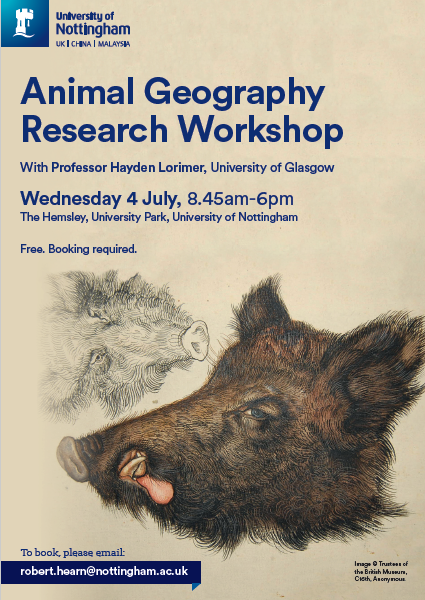Lively worlds, lively discipline: Animal Geography Research Workshop, University of Nottingham
Lively worlds, lively discipline: Animal Geography Research Workshop, University of Nottingham
In July 2018 several members of the Animal Research Nexus team were invited to an exciting workshop at the University of Nottingham. The aim of the meeting was to allow people researching ‘animal geographies’ from different approaches to discuss their current research. Animal geography is ‘a lively and provocative area of current human/non-human geographical research and scholarship’ (Buller, 2013) that explores ‘the complex nexus of spatial relations between people and animals’ (Philo and Wolch, 1998).
Organised by Dr Robert Hearn and Professor Charles Watkins of the University of Nottingham’s School of Geography, the workshop was a great success with people travelling from all over the UK, and even from across Europe, to attend. Discussions ranged from the complex politics surrounding feral boar, to the relationships between assistance dogs for people affected by visual impairments, and even a discussion about the representations of farm animals on the theatre stage.

Renelle McGlacken from the Nottingham Animal Research Nexus team presented on the work that she is doing with Pru Hobson-West (People and Professions, Nottingham) on the need for more nuanced understanding of how publics think about animal research. Renelle demonstrated how different forms of ‘public’ are constructed and evoked to simultaneously support and challenge animal research, and the multifaceted imaginations and representations of both ‘public’ and ‘animal research’ that ensue.
Beth Greenhough (Species and Spaces, Oxford) discussed the collaborative work that herself, Emma Roe (Markets and Materials, Southampton) discussed their collaborative work, and Reuben Message (Species and Spaces, Oxford) have been doing, exploring how animal technologists who work with cold-blooded species sense and respond to the needs of aquatic species in the laboratory. They discussed how for aquatic species, environmental quality often serves as a proxy for species health, as well as noting that the regulation for the care and use of aquatic and especially invertebrate species is frequently limited. However, their work also identified the capacities of animal technologists to learn to be affected by aquatic species, cultivating a sensitivity to animals, even in their watery worlds.
Rich Gorman (Engagement and Involvement, Exeter) discussed some of his previous work exploring how animals can create therapeutic opportunities for a variety of people affected by different health conditions. Rich demonstrated how relationships between people and animals can create affective encounters that enable people to live fuller lives. Using case studies of work in the US, Rich also highlighted opportunities for animal-assisted-therapy practices to consider how they might be reciprocally beneficial – bringing care for vulnerable animals and care for vulnerable humans together in a way that has mutual benefits.
The work of the Animal Research Nexus, and its wider connections to discussions of care, welfare, and publicness, prompted great interest and discussion amongst our fellow workshop delegates. It was fantastic to see that other people are as excited about the research we are doing as we all are!
Many thanks to Robert and Charles for organising and inviting us all, and convening a thrilling programme that truly highlights the lively and vibrant nature of ‘animal geography’.